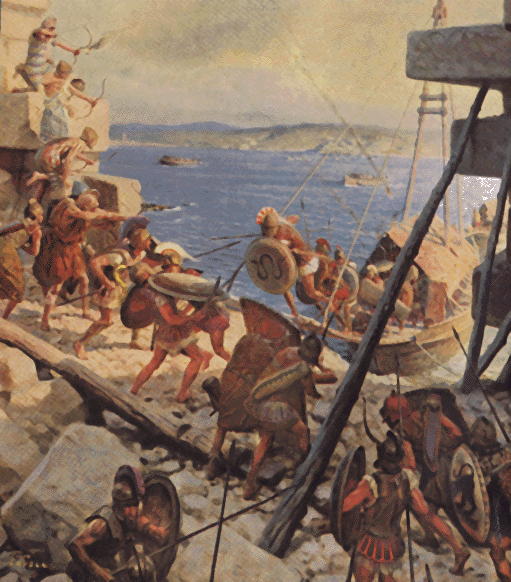Alexander's Battles

Battle of Granicus
The battle between Macedonian king Alexander the Great and armies of the Persian Empire at the
Granicus River in Asia Minor. When Alexander started his war against the Persians in the spring of
334 BC, he was met at the Granicus by an army of Persian soldiers and Greek hoplites.
The Persian force stationed itself at the top of a steep bank on the opposite side of the river.
The Persian plan was to concentrate their attack upon Alexander in the hope he might be killed, but
Alexander led a successful charge across the river and routed them. According to tradition, Alexander
lost only 110 soldiers. After the Battle of Granicus, all the states of Asia Minor submitted to
Alexander the Great.

Battle of Issus
The engagement fought in 333 BC between Macedonian king Alexander the Great and Persian king
Darius III during Alexander's conquest of the Persian Empire. After invading northern Syria,
Alexander left his wounded soldiers in a camp in the city of Issus, directing the remainder of
his army southward in search of Darius's armies. Meanwhile, Darius moved his army up from the
south. In a maze of Syrian mountains, the two armies passed each other. Darius discovered
Alexander's camp at Issus and massacred the wounded Macedonian soldiers. After Alexander found
himself cut off from communication with the north, he returned to Issus and defeated Darius's
army. Darius fled to Babylonia, leaving Syria, Palestine, and Egypt open for conquest by Alexander.
Battle of Tyre
Storming defiant Tyre, Macedonian warriors charge through a breach in the island-cities high walls
>in July, 332 B.C. Seven months earlier, Tyre looked impregnable. To reach it from the Phoenician shore,
half a mile away, Alexander constructed a broad mole guarded by towers. But as the causeway neared the
island, Tyrians bombaeded the workers with stones and arrows, forcing Alexander to adopt a knew plan.
On ships collected from other Phoenician cities, his engineers mounted siege machines-catapults and
iron-headed battering rams. The ships pounded the wall until a weak spot collapsed. Here, sheilded from
a rain of burning arrows by a hide tent, the Macedonians reach shore and drop a long gangplank to carry them over the rubble. After desperate hand-to-hand combat, Tyre fell and Alexander closed this main base of the Persian fleet, winning control of the eastern Mediterranean after the longest battle of his life. They massacred 8,000 Tyrians and sold 30,000 into slavery.

Battle at Gaugamela
The armies of Alexander the Great and the Persian monarch Darius III, fought in 331
BC. The Persian defeat opened the East to the Macedonians. Alexander, with 40,000 infantry
and 7000 cavalry, invaded Persia from Egypt. The Persian army assembled about 250,000 men
on the plain of Gaugamela, in what is now Iraq. Alexander attacked the Persian left flank
and then broke through their center. Darius fled and the Persians retreated. The Persians
lost tens of thousands of men in the battle, and the Macedonians lost fewer than 500.




